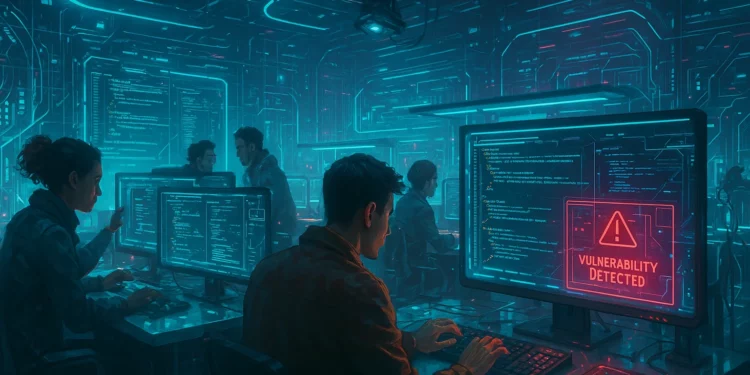Secure Coding continues to evolve as a critical approach for creating robust, secure software in an increasingly complex technological landscape. The practice of anticipating and addressing potential issues before they arise is no longer optional but essential for organizations aiming to build resilient applications.
This article explores the top trends shaping defensive programming in 2025, providing insights into how developers and organizations can stay ahead of emerging challenges.
The Evolution of Secure Coding in 2025
Defensive programming has matured significantly since its inception, transforming from a set of cautionary coding practices into a comprehensive methodology for ensuring software quality and security. As defined by wikipedia, this is “a form of defensive design intended to develop programs that are capable of detecting potential security abnormalities and make predetermined responses, ensuring the continuing function of software under unforeseen circumstances“.
In 2023, we identified secure programming as an approach that “prioritizes anticipating and addressing potential issues before they arise, thereby enhancing the stability of a product“.
In 2025, this concept has expanded to embrace new technologies, methodologies, and security challenges that were merely emerging a few years ago.
Trend 1: AI-Enhanced Secure Coding
Artificial intelligence is revolutionizing risk-aware programming practices in 2025, creating both new challenges and powerful solutions for developers.
AI for Vulnerability Detection and Prevention
Generative AI has become a game-changer in the cybersecurity landscape, with significant implications for defensive programming. As John Campbell, Director of Content Engineering at Security Journey, notes, “Hackers are using it to make smarter attacks, like crafting super-convincing phishing emails, while defenders are using it to step up their game with better threat detection and automated responses“.
AI-powered tools now assist developers in:
Automatically identifying potential vulnerabilities during code creation
Suggesting defensive coding patterns based on context
Conducting more thorough and intelligent code reviews
Predicting potential attack vectors before they’re exploited
Organizations implementing AI-enhanced defensive coding strategies are seeing substantial reductions in both the number of vulnerabilities reaching production and the time required to identify and address potential issues.
Trend 2: Secure Coding Within DevSecOps Frameworks
In 2025, robust application design has become tightly integrated with DevSecOps practices, embedding security throughout the software development lifecycle rather than treating it as an afterthought.
Continuous Security Integration
Modern development practices now incorporate defensive programming principles into continuous integration/continuous deployment (CI/CD) pipelines. This represents a significant shift from earlier approaches where security was often addressed only after development was complete.
“Continuous integration streamlines the development process and reduces integration issues,” notes a recent industry report on essential developer practices1. This integration ensures that defensive programming practices are applied consistently throughout development.
Key elements of this trend include:
Automated security checks at each stage of development
Pre-commit hooks that validate code against defensive programming requirements
Real-time feedback on potential security issues during development
Shared responsibility for security across development, operations, and security teams
Trend 3: Enhanced Input Validation and Error Handling
As attacks grow more sophisticated in 2025, Secure Coding techniques for input validation and error handling have evolved significantly.
Beyond Basic Validation
“Defensive programming is about writing code to handle cases that you do not think will, or even can happen, because you have a belief that your own beliefs are unreliable or assuming the worst case: that your users are complete crazy people and you must defend yourself and your program from their crazy inputs” (source).
Modern defensive programming in 2025 goes beyond simple type checking to implement:
Context-aware validation that understands the semantic meaning of inputs
Machine learning models that identify anomalous inputs based on patterns
Graceful degradation mechanisms that maintain core functionality even when parts of a system fail
Comprehensive logging that enables rapid response to previously unknown attack vectors
Trend 4: Regulatory Compliance Driving Secure Coding
New regulatory requirements are significantly influencing defensive programming practices in 2025, with organizations facing stricter compliance mandates.
PCI DSS v4.0 and Beyond
The implementation of PCI DSS v4.0 represents one example of how regulatory frameworks are elevating code quality assurance requirements. This updated standard introduces new requirements and emphasizes a risk-based approach to security with emphasis on continuous compliance, rather than just pass/fail assessments.
Other regulatory trends driving defensive programming in 2025 include:
Industry-specific security requirements for critical infrastructure
Data privacy regulations requiring verifiable security measures
Government contracts mandating specific defensive coding practices
International standards harmonization creating more consistent requirements
Trend 5: Offensive Programming as a Defensive Strategy
Offensive programming, a subset of Secure Coding, has gained prominence in 2025 as organizations adopt a more proactive security stance.
Think Like an Attacker
Offensive cybersecurity focuses on actively seeking out systems’ vulnerabilities, flaws, and weaknesses before attackers can exploit them. The premise behind OffSec is simple: to best defend oneself, one must think and act like an attacker.
This approach manifests in defensive programming through:
Penetration testing integrated into development processes
Red team exercises that attempt to exploit application vulnerabilities
Code designed with explicit internal validation checks rather than trusting all internal data
Frameworks that separate inputs across trust boundaries
Offensive programming emphasizes that certain errors should not be handled defensively. In this practice, only errors from outside the program’s control are to be handled (such as user input); the software itself, as well as data from within the program’s line of defense, are to be trusted in this methodology.
Trend 6: Secure Coding for Critical Infrastructure
The increased digitization of infrastructure has elevated the importance of defensive programming in critical systems.
Higher Standards for Critical Systems
As the defense sector marches down an increasingly digitized path in 2025 with AI revolutionizing maintenance and repair and autonomous systems reshaping naval warfare, cybersecurity threats continue to grow.
Defensive programming for critical infrastructure in 2025 includes:
Formal verification techniques ensuring mathematical correctness
Redundant systems with different implementation approaches
Stricter constraints on third-party dependencies
Memory-safe programming languages gaining adoption in critical contexts
Comprehensive failure mode analysis integrated into development
Implementing Secure Coding in Your Organization
To effectively implement defensive programming in 2025, organizations should consider these approaches:
Establish Clear Guidelines and Standards
Code comprehension remains an integral part of defensive programming, requiring adherence to principles like the Single Responsibility Principle, Separation of Concerns, and the Don’t Repeat Yourself (DRY) principle.
Invest in Training and Tools
Ensure your development team understands both the theory and practice of Error-handling techniques. The “primary aim of defensive programming is to enhance both the quality and predictability of the software, thereby reducing the number of bugs, errors, and vulnerabilities“.
Adopt a Risk-Based Approach
Focus defensive programming efforts on the most critical parts of your application first. Use risk analysis and consider what could go wrong, how much chance is there of it going wrong, what would the impact be, how could you prevent it from going wrong, and what would it cost to implement prevention or recovery.
Conclusion
Defensive programming continues to evolve in 2025, adapting to new threats, technologies, and development methodologies. By embracing AI-enhanced tools, integrating with DevSecOps practices, addressing quantum threats, meeting regulatory requirements, adopting offensive strategies, and prioritizing critical infrastructure, organizations can build more resilient software systems.
Secure programming remains an essential approach for creating software that can withstand the unexpected. By anticipating and addressing potential issues before they arise, developers can create applications that not only meet current needs but remain robust in the face of future challenges.
Remember that resilient coding practices is not just about writing more code—it’s about writing smarter, more resilient code that anticipates real-world conditions. As noted by programming experts, the goal is to “use the right amount of defensive programming where necessary” while avoiding “overusing defensive programming if it’s not necessary“.


